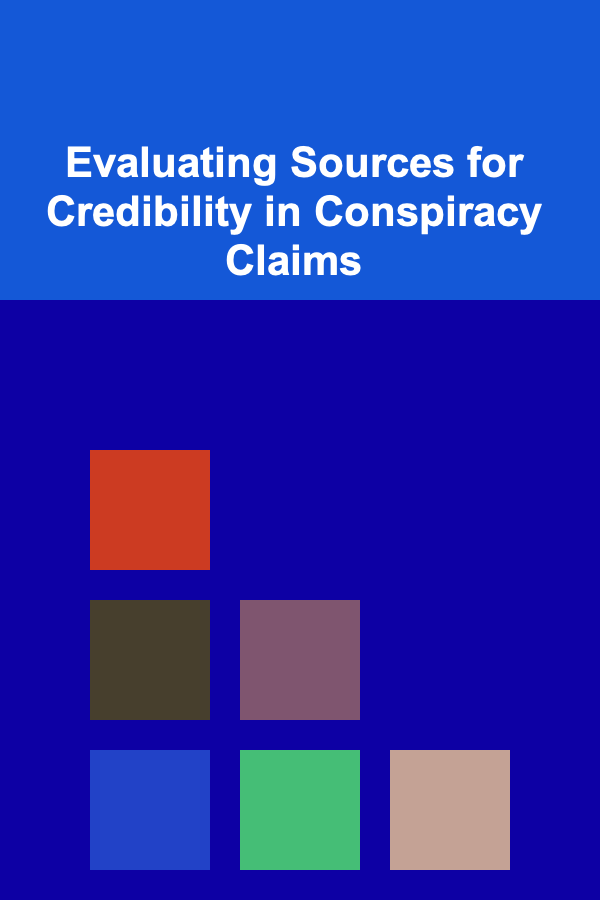
Evaluating Sources for Credibility in Conspiracy Claims
ebook include PDF & Audio bundle (Micro Guide)
$12.99$5.99
Limited Time Offer! Order within the next:

In an era defined by readily available information and the proliferation of online platforms, the landscape of news and knowledge consumption has become increasingly complex. While this accessibility offers unparalleled opportunities for learning and connection, it also presents significant challenges, particularly when navigating the murky waters of conspiracy theories. Conspiracy claims, often lacking empirical evidence and relying on speculation or anecdotal accounts, can spread rapidly through social media and alternative news sources, influencing public opinion and fueling distrust in established institutions. Therefore, developing critical thinking skills to evaluate sources for credibility is paramount, especially when encountering information related to conspiracy theories. This article delves into the multifaceted process of assessing sources, equipping readers with the tools necessary to discern reliable information from potentially misleading or fabricated content within the realm of conspiracy claims.
Understanding the Nature of Conspiracy Claims
Before delving into the methodologies for evaluating sources, it's crucial to understand the characteristics and common pitfalls associated with conspiracy claims. These claims typically involve secretive and malevolent plots orchestrated by powerful individuals or organizations to manipulate events or deceive the public. Often, they arise in the wake of significant events, such as political assassinations, natural disasters, or public health crises, seeking to provide alternative explanations that challenge the official narrative.
Several psychological and social factors contribute to the appeal and spread of conspiracy theories. These include:
- The Need for Certainty: In the face of uncertainty and ambiguity, conspiracy theories can offer a simplified and seemingly coherent explanation of complex events, providing a sense of control and understanding.
- Distrust in Authority: Erosion of trust in government, media, and scientific institutions can make individuals more receptive to alternative narratives that challenge the status quo.
- Confirmation Bias: Individuals tend to seek out and interpret information that confirms their existing beliefs, even if that information is unreliable or biased. This is particularly dangerous in the context of conspiracy theories, as it creates an echo chamber reinforcing the belief.
- Social Identity: Believing in a particular conspiracy theory can become part of an individual's identity and connect them with like-minded individuals in online communities.
- Epistemic Motives: The desire to feel informed and have access to special knowledge can lead individuals to embrace conspiracy theories, even if the evidence is weak.
Recognizing these underlying factors is essential for approaching conspiracy claims with a critical and objective mindset.
Key Criteria for Evaluating Sources
Evaluating the credibility of sources involves a systematic assessment based on several key criteria. These criteria are applicable to a wide range of information sources, but they are particularly important when dealing with conspiracy claims, where the potential for bias and misinformation is high.
1. Accuracy and Verifiability
The foundation of any credible source is accuracy. Information should be factually correct and supported by evidence. This requires a thorough examination of the claims made by the source and a comparison with other reliable sources.
Strategies for Assessing Accuracy:
- Fact-Checking: Utilize reputable fact-checking websites like Snopes, PolitiFact, FactCheck.org, and the Associated Press (AP) Fact Check to verify the accuracy of specific claims. These organizations employ rigorous methodologies to investigate claims and provide evidence-based assessments.
- Cross-Referencing: Compare information from the source with information from multiple independent and reliable sources. Look for consistency and corroboration. If the source presents information that contradicts well-established facts or is not supported by other sources, it raises a red flag.
- Evidence of Citations: Look for citations to credible sources. Does the source provide clear references to the data, research, or documents upon which it relies? Vague or absent citations suggest a lack of rigor and may indicate that the information is not based on evidence.
- Scrutinize Statistics and Data: Be wary of statistics or data presented without proper context or methodology. Ensure that the data is from a reliable source and is interpreted accurately. Misleading use of statistics is a common tactic in promoting conspiracy theories.
Example: A conspiracy website claims that vaccines cause autism, citing a retracted study. Fact-checking websites debunk this claim and provide numerous studies demonstrating the safety and efficacy of vaccines. Cross-referencing with reputable medical organizations like the CDC and WHO further reinforces the scientific consensus on vaccine safety.
2. Authority and Expertise
The credibility of a source is strongly linked to the author's or organization's expertise and credentials in the relevant field. A source with demonstrated knowledge and experience is more likely to provide accurate and reliable information.
Strategies for Assessing Authority:
- Identify the Author or Organization: Determine who is responsible for the information. Is it an individual, an organization, or an anonymous source?
- Research Credentials: Investigate the author's or organization's background, qualifications, and affiliations. Do they have relevant expertise or experience in the subject matter? Look for academic degrees, professional certifications, publications, and affiliations with reputable institutions.
- Evaluate the Organization's Mission: Understand the organization's goals and objectives. Is it a non-profit, a for-profit company, a government agency, or an advocacy group? Consider whether the organization's mission might influence its perspective or bias its reporting.
- Beware of Anonymity: Be cautious of sources that rely on anonymous individuals or unidentified "insiders." While there may be legitimate reasons for anonymity in some cases (e.g., whistleblowing), it also makes it difficult to verify the source's credibility and motivations.
Example: A blog post claiming that climate change is a hoax is written by an individual with no background in climate science. In contrast, a report on climate change is published by the Intergovernmental Panel on Climate Change (IPCC), a leading international scientific body composed of experts from around the world. The IPCC report carries significantly more weight due to the expertise and authority of its authors.
3. Objectivity and Bias
Objectivity refers to the presentation of information in a neutral and unbiased manner, free from personal opinions or agendas. All sources have a perspective, but credible sources strive to present information fairly and accurately, acknowledging different viewpoints.
Strategies for Assessing Objectivity:
- Identify the Purpose: Determine the source's purpose in providing the information. Is it to inform, persuade, entertain, or sell a product? Sources with a clear agenda may be more likely to present information selectively or in a biased manner.
- Look for Balance: Does the source present multiple perspectives on the issue? Does it acknowledge opposing viewpoints or criticisms of its claims? A source that only presents one side of the story may be biased.
- Analyze the Language: Pay attention to the language used by the source. Does it use emotionally charged language, loaded terms, or personal attacks? Such language can be a sign of bias.
- Consider Conflicts of Interest: Identify any potential conflicts of interest that might influence the source's objectivity. For example, a company promoting a product might be biased in its assessment of the product's safety or efficacy.
Example: A news article reporting on a political controversy quotes both supporters and opponents of the policy in question. In contrast, a partisan website presents only one side of the issue, using inflammatory language to attack the opposing viewpoint. The news article is more likely to be objective.
4. Currency and Timeliness
The currency of information is particularly important in fields that are rapidly evolving, such as science, technology, and current events. Outdated information may be inaccurate or incomplete.
Strategies for Assessing Currency:
- Check the Publication Date: Determine when the information was created or published. Pay attention to the date of articles, studies, and website updates.
- Consider the Subject Matter: How important is currency to the topic being discussed? For historical topics, older sources may be perfectly acceptable. For rapidly evolving topics, recent sources are essential.
- Look for Updates: Has the information been updated or revised? Check for indications that the source has incorporated new findings or corrected errors.
Example: An article on the COVID-19 pandemic published in early 2020 may contain outdated information about the virus, its transmission, and available treatments. More recent articles from reputable medical journals and public health organizations provide the most up-to-date information.
5. Reliability and Reputation
The overall reliability and reputation of a source are crucial indicators of its credibility. Sources with a track record of accuracy, objectivity, and responsible reporting are more likely to provide trustworthy information.
Strategies for Assessing Reliability:
- Consider the Source's History: Research the source's reputation for accuracy and reliability. Has it been known to publish false or misleading information in the past? Has it been subject to criticism or corrections?
- Look for Peer Review: In academic and scientific fields, peer review is a process in which experts in the field evaluate research before it is published. Peer-reviewed publications are generally considered to be more reliable.
- Check for Retractions: Has the source ever retracted an article or study due to errors or misconduct? Retractions indicate a serious problem with the source's credibility.
- Read Reviews and Ratings: Consult reviews and ratings of the source from other organizations or individuals. Be aware that reviews can be subjective, but they can provide valuable insights into the source's reputation.
Example: The New York Times and the BBC are generally considered to be reliable news sources with a long history of journalistic integrity. In contrast, a website known for spreading misinformation and conspiracy theories is unlikely to be a reliable source.
Specific Considerations for Conspiracy Claims
While the general criteria for evaluating sources are applicable to all types of information, there are specific considerations that are particularly important when dealing with conspiracy claims.
1. Motives and Agendas
Understanding the motives and agendas of those promoting conspiracy theories is crucial. Are they seeking to profit financially, gain political influence, or promote a particular ideology? Conspiracy theories are often used to manipulate public opinion or to justify violence and extremism.
Strategies for Assessing Motives:
- Follow the Money: Who is funding the conspiracy theory? Are there any financial incentives involved?
- Identify the Ideology: What political or social ideology is the conspiracy theory promoting?
- Consider the Consequences: What are the intended consequences of the conspiracy theory? Is it designed to incite hatred, violence, or distrust?
2. Lack of Empirical Evidence
A defining characteristic of conspiracy theories is their lack of empirical evidence. They often rely on speculation, anecdotal accounts, and distorted interpretations of facts. The absence of verifiable evidence is a major red flag.
Strategies for Assessing Evidence:
- Demand Evidence: Ask for verifiable evidence to support the claims being made. Do not accept unsubstantiated assertions or vague generalizations.
- Look for Independent Verification: Can the claims be independently verified by reputable sources?
- Be Wary of "Hidden" Evidence: Conspiracy theorists often claim that the evidence is being suppressed or hidden by powerful forces. Such claims should be treated with extreme skepticism.
3. Confirmation Bias and Echo Chambers
Individuals who believe in conspiracy theories are often trapped in echo chambers, where they are only exposed to information that confirms their existing beliefs. This reinforces their convictions and makes them less likely to consider alternative perspectives.
Strategies for Overcoming Confirmation Bias:
- Seek Out Diverse Perspectives: Actively seek out information from sources with different viewpoints.
- Challenge Your Own Beliefs: Be willing to question your own assumptions and biases.
- Engage in Civil Discourse: Engage in respectful dialogue with individuals who hold different opinions.
4. The Appeal to Emotion
Conspiracy theories often appeal to emotions such as fear, anger, and resentment. They can exploit anxieties and insecurities to gain traction.
Strategies for Resisting Emotional Manipulation:
- Be Aware of Emotional Appeals: Recognize when a source is attempting to manipulate your emotions.
- Maintain a Rational Perspective: Approach the information with a calm and rational mindset.
- Focus on Facts and Evidence: Base your judgments on facts and evidence, not on emotions.
5. The Use of Logical Fallacies
Conspiracy theories often rely on logical fallacies, such as ad hominem attacks, straw man arguments, and false dilemmas, to discredit opposing viewpoints and promote their own claims.
Strategies for Identifying Logical Fallacies:
- Learn Common Logical Fallacies: Familiarize yourself with common logical fallacies, such as ad hominem attacks, straw man arguments, and false dilemmas.
- Analyze the Arguments: Carefully analyze the arguments being made by the source. Do they rely on logical fallacies?
- Focus on the Substance: Evaluate the substance of the claims, not the way they are presented.
Practical Steps for Evaluating Sources
Here's a step-by-step guide to evaluating sources for credibility in conspiracy claims:
- Identify the Source: Determine who is responsible for the information.
- Assess the Authority: Research the author's or organization's credentials and expertise.
- Evaluate the Objectivity: Identify the source's purpose and look for bias.
- Check for Accuracy: Fact-check claims and cross-reference information with other reliable sources.
- Assess the Currency: Determine when the information was published and whether it is up-to-date.
- Consider the Reliability: Research the source's reputation for accuracy and reliability.
- Analyze the Motives: Understand the motives and agendas of those promoting the conspiracy theory.
- Scrutinize the Evidence: Demand verifiable evidence to support the claims being made.
- Resist Emotional Manipulation: Be aware of emotional appeals and maintain a rational perspective.
- Identify Logical Fallacies: Analyze the arguments being made by the source and look for logical fallacies.
Conclusion
In the digital age, the ability to critically evaluate sources is more important than ever. When encountering conspiracy claims, it is crucial to approach information with a skeptical and objective mindset, applying the criteria outlined in this article. By carefully assessing the accuracy, authority, objectivity, currency, and reliability of sources, individuals can better discern credible information from misinformation and make informed decisions. Furthermore, understanding the psychological and social factors that contribute to the spread of conspiracy theories can help to mitigate their influence and promote a more rational and evidence-based understanding of the world. The effort required to evaluate sources properly is a crucial investment in one's understanding and ability to navigate the complex information environment.
Reading More From Our Other Websites
- [Home Cleaning 101] How to Clean and Maintain Your Home's Baseboards
- [Home Cleaning 101] How to Clean Your Home Without Harmful Chemicals
- [Toy Making Tip 101] Handcrafted Joy: Simple Toy Projects to Gift Your Loved Ones
- [Whitewater Rafting Tip 101] Conquering the Whitewater: A Beginner's Guide to Rafting Rapids
- [Home Maintenance 101] How to Maintain Hardwood Floors to Keep Them Looking New
- [Home Cleaning 101] How to Organize and Clean Your Linen Closet
- [Home Security 101] How to Create a Neighborhood Watch Program for Added Safety
- [Organization Tip 101] How to Create a Stylish Gallery Wall in a Small Home
- [Home Staging 101] How to Leverage Outdoor Spaces with Smart Summer Home Staging Tips
- [Home Renovating 101] How to Incorporate Feng Shui in Your Home Renovation

Effective Strategies for Event Managers: Mastering Logistics and Coordination
Read More
How to Clean and Care for Your Kitchen Sink
Read More
How to Create a Joint Budget Using the Best Budgeting App for Couples
Read More
How to Make Money Online as a Nurse Practitioner: 10 Actionable Ideas
Read More
How to Reinvest Profits for Growth
Read More
How To Create a Job Search Action Plan
Read MoreOther Products

Effective Strategies for Event Managers: Mastering Logistics and Coordination
Read More
How to Clean and Care for Your Kitchen Sink
Read More
How to Create a Joint Budget Using the Best Budgeting App for Couples
Read More
How to Make Money Online as a Nurse Practitioner: 10 Actionable Ideas
Read More
How to Reinvest Profits for Growth
Read More